实验目的实验要求及实验环境
实验计划内容
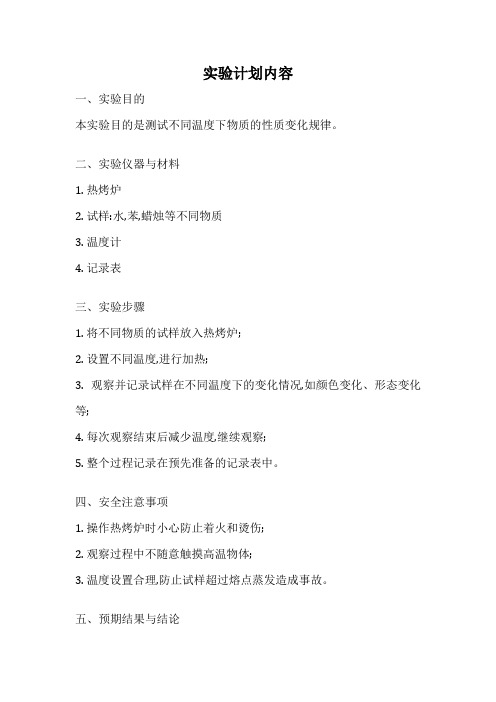
实验计划内容
一、实验目的
本实验目的是测试不同温度下物质的性质变化规律。
二、实验仪器与材料
1. 热烤炉
2. 试样:水,苯,蜡烛等不同物质
3. 温度计
4. 记录表
三、实验步骤
1. 将不同物质的试样放入热烤炉;
2. 设置不同温度,进行加热;
3. 观察并记录试样在不同温度下的变化情况,如颜色变化、形态变化等;
4. 每次观察结束后减少温度,继续观察;
5. 整个过程记录在预先准备的记录表中。
四、安全注意事项
1. 操作热烤炉时小心防止着火和烫伤;
2. 观察过程中不随意触摸高温物体;
3. 温度设置合理,防止试样超过熔点蒸发造成事故。
五、预期结果与结论
通过观察,可以掌握不同物质在不同温度下的特殊性质,帮助理解物质结构与性质之间的关系。
本次实验获得了______的实验结果及结论。
检测不同环境中的细菌和真菌实验报告
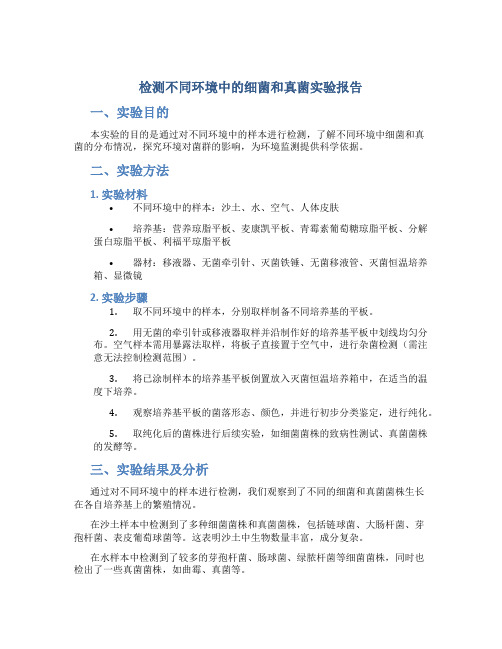
检测不同环境中的细菌和真菌实验报告一、实验目的本实验的目的是通过对不同环境中的样本进行检测,了解不同环境中细菌和真菌的分布情况,探究环境对菌群的影响,为环境监测提供科学依据。
二、实验方法1. 实验材料•不同环境中的样本:沙土、水、空气、人体皮肤•培养基:营养琼脂平板、麦康凯平板、青霉素葡萄糖琼脂平板、分解蛋白琼脂平板、利福平琼脂平板•器材:移液器、无菌牵引针、灭菌铁锤、无菌移液管、灭菌恒温培养箱、显微镜2. 实验步骤1.取不同环境中的样本,分别取样制备不同培养基的平板。
2.用无菌的牵引针或移液器取样并沿制作好的培养基平板中划线均匀分布。
空气样本需用暴露法取样,将板子直接置于空气中,进行杂菌检测(需注意无法控制检测范围)。
3.将已涂制样本的培养基平板倒置放入灭菌恒温培养箱中,在适当的温度下培养。
4.观察培养基平板的菌落形态、颜色,并进行初步分类鉴定,进行纯化。
5.取纯化后的菌株进行后续实验,如细菌菌株的致病性测试、真菌菌株的发酵等。
三、实验结果及分析通过对不同环境中的样本进行检测,我们观察到了不同的细菌和真菌菌株生长在各自培养基上的繁殖情况。
在沙土样本中检测到了多种细菌菌株和真菌菌株,包括链球菌、大肠杆菌、芽孢杆菌、表皮葡萄球菌等。
这表明沙土中生物数量丰富,成分复杂。
在水样本中检测到了较多的芽孢杆菌、肠球菌、绿脓杆菌等细菌菌株,同时也检出了一些真菌菌株,如曲霉、真菌等。
在空气样本中检测到了多种细菌菌株,主要包括链球菌、葡萄球菌、沙眼衣原体等。
空气中的细菌数量相比沙土和水要少得多,种类也相对单一。
在人体皮肤样本中,检测到了多种细菌菌株和真菌菌株,包括金黄色葡萄球菌、表皮葡萄球菌、马拉色葡萄球菌等。
这表明人体皮肤表面存在着大量的微生物。
通过观察不同环境中的菌落繁殖情况,我们可以发现,细菌和真菌的分布受到环境的影响很大,不同环境中的微生物组成差异很大。
在进行环境监测时,我们需要考虑到不同环境中微生物的分布情况,制定合理的采样方案和检测方法。
关于计算机实验报告的范文

关于计算机实验报告的范文实验名称:计算机硬件组装与基础设置一、实验目的1. 了解计算机硬件基本组成和功能;2. 掌握计算机基础设置方法;3. 增强实际操作能力和理论知识的应用能力。
二、实验设备及环境1. 实验设备:计算机硬件(主板、CPU、内存、硬盘、显卡等)、电源、机箱、数据线、螺丝刀等;2. 实验软件:操作系统、驱动程序、系统设置软件等;3. 实验环境:干净的系统盘、稳定的电源和良好的实验台等。
三、实验步骤及要点1. 硬件组装:按照主板、CPU、内存、硬盘、显卡等顺序将硬件安装到机箱中;2. 数据线连接:将各个硬件之间的数据线连接好;3. 螺丝固定:用螺丝刀将各硬件固定在机箱上;4. 基础设置:通过BIOS和操作系统对计算机进行基本设置和启动测试。
四、实验结果及总结通过本次实验,我对计算机的硬件组成有了更深入的了解,掌握了硬件的安装、连接和固定等实际操作技能。
在基础设置过程中,我熟悉了BIOS的设置、硬盘的分区和格式化、操作系统的安装和基本设置等步骤。
实验过程中需要注意的事项很多,稍不注意就会导致硬件的损坏,因此,实际操作中需要格外小心。
实验名称:计算机系统优化与调整一、实验目的1. 了解计算机系统优化与调整的方法;2. 掌握使用工具软件进行系统优化与调整的操作;3. 增强实际操作能力和理论知识的应用能力。
二、实验设备及环境1. 实验设备:计算机硬件、操作系统及常用工具软件;2. 实验环境:稳定的网络环境、干净的操作系统盘。
三、实验步骤及要点1. 系统优化:使用工具软件对计算机系统进行性能优化,如关闭不必要的启动项、优化系统配置文件等;2. 系统调整:对计算机系统的参数进行调整,如内存分配、磁盘缓存大小等;3. 操作测试:对优化和调整后的系统进行操作测试,观察系统性能的变化。
四、实验结果及总结通过本次实验,我熟悉了使用工具软件对计算机系统进行优化和调整的操作方法。
实验过程中需要注意,一些操作可能会影响系统的稳定性,因此需要谨慎操作。
实验报告中硬件环境

一、实验名称XXX实验二、实验目的XXX三、实验时间XXX四、实验地点XXX实验室五、实验仪器及设备1. 主机(1)品牌:XXX(2)型号:XXX(3)配置:CPU:Intel XXX GHz,内存:XXX GB,硬盘:XXX GB 2. 显示器(1)品牌:XXX(2)型号:XXX(3)分辨率:XXX3. 键盘(1)品牌:XXX(2)型号:XXX4. 鼠标(1)品牌:XXX(2)型号:XXX5. 外部存储设备(1)品牌:XXX(2)型号:XXX(3)容量:XXX GB6. 电源(1)品牌:XXX(2)型号:XXX(3)功率:XXX W7. 其他设备(1)网络设备:路由器、交换机等(2)传感器:XXX、XXX等(3)实验台、实验架等六、实验环境1. 实验室环境(1)温度:保持在20-25℃之间(2)湿度:保持在40%-70%之间(3)噪音:控制在60分贝以下2. 网络环境(1)网络类型:有线/无线(2)网络速率:XXX Mbps(3)IP地址:XXX.XXX.XXX.XXX 3. 软件环境(1)操作系统:Windows XXX(2)编程语言:XXX(3)数据库:XXX(4)开发工具:XXX七、实验数据及结果1. 实验数据(1)实验过程中所使用的实验数据,如实验步骤、参数设置等(2)实验过程中所收集的数据,如实验结果、测量值等2. 实验结果(1)实验过程中所得到的结果,如实验现象、数据变化等(2)实验过程中所遇到的问题及解决方法八、实验结论根据实验数据及结果,得出以下结论:1. 实验达到了预期目标,验证了XXX2. 实验过程中发现XXX问题,并提出了相应的解决方案3. 实验结果具有一定的参考价值,为XXX提供了理论依据九、实验心得通过本次实验,我掌握了XXX方法,了解了XXX原理,提高了XXX能力。
同时,我也认识到实验过程中需要注意以下几点:1. 实验前应充分了解实验原理和步骤2. 实验过程中要严格按照操作规程进行,确保实验安全3. 实验数据要准确记录,以便后续分析4. 遇到问题时要积极思考,寻求解决办法5. 实验结束后要及时总结经验,提高实验技能十、实验报告附件1. 实验原理图2. 实验数据表格3. 实验结果图表4. 实验步骤图5. 其他相关资料注:本实验报告仅供参考,具体内容请根据实际实验情况进行修改。
环境监测实验

实验一、环境实验基本要求实验是本课程教学中的一个重要环节,实验目的是为了使学生加强理论与实践相结合的能力,培养学生严肃认真和实是求是的工作作风和科学态度,锻炼在实践中分析问题和解决问题的聪明才智,激发努力开拓不断创新的精神。
为使实验达到预期目的,特提出如下要求:一、学生要求:1、实验课前,应预习实验内容,了解实验目的、原理、步骤以及所需仪器、器材、化学药品。
2、进入实验室,要服从安排,遵守纪律,令行禁止。
不准喧哗打闹、随意更换座位、随意搬动或调换他人的仪器、器材;不准乱丢纸屑、废物,不做与实验无关的事。
3、实验前,认真听讲,进一步明确实验目的、操作要点及注意事项。
进一步了解仪器装置的构造、原理、化学药品的性能。
不要提前摆弄仪器或做实验。
4、实验时,必须按照正确的方法和正确的操作步骤进行实验、认真观察、分析,作好记录。
按时完成实验。
5、实验后应先切断电源然后拆线,把仪器、设备和导线整理好,保持实验室清洁。
6、实验完毕,要做好清洁工作,经教师认可后方可离开实验室。
7、按要求写实验报告,报告字迹要整齐,数据计算、图表、曲线均应符合要求。
6、爱护公共财产,节约水电、器材和药品,如因不守纪律、违章操作,损坏仪器设备,浪费器材或药品,要照价赔偿。
7、切实注意安全,防止触电、中毒、着火、烧伤、割伤、碰伤等事故发生。
一旦发生事故,应立即报告教师及时处理。
8、独立完成实验报告。
实验二废水悬浮固体和浊度的测定一、目的悬浮固体系指剩留在滤料上并于103~105℃烘至恒重的固体。
浊度是表现水中悬浮物对光线透过时所发生的阻碍程度。
水中含有泥土、微细有机物、无机物、浮游动物和其他微生物等悬浮物和胶体物都可使水样呈现浊度。
水的浊度大小不仅与水中的颗粒物含量有关,而且与其粒径大小、形状、颗粒表面对光散射特性有密切关系。
本实验的目的是让学生掌握水体中悬浮固体和浊度的测定方法。
二、悬浮固体的测定(一)原理测定的方法是将水样通过滤料后,烘干固体残留物及滤料,将所称重量减去滤料重量,即为悬浮固体(总不可滤残渣)。
电磁炮实验报告(共10篇)

电磁炮实验报告(共10篇)
一、实验目的
实验的目的是探究电磁炮的性能特点,确定它在各种工作状态下的性能指标。
二、实验环境
在本实验中,采取了常温室环境,室内温度维持在22.8 ℃左右,室内湿度保持在
53.4%左右。
三、实验材料
本次实验所用到的材料主要有:
(1)电磁炮:一台电磁炮,电机输出7.5 KW,转速130 rpm。
(2)焊条:一种6mm直径,长度约120mm的焊条,铜丝表面厚度2.2mm。
(3)焊枪:一个电磁炮焊枪,能够把电磁炮的8Kv电流输出,焊条被热溶后形成一
个加热电抛物线。
四、实验方法
(1)检查仪器:仔细检查电磁炮是否工作正常,并进行加电安全检查;另外,还要
确定焊条的材料和规格,以确定实验的数据准确。
(2)安装设备:在实验设备正确安装后,应满足以下条件:a)焊枪应连接到电磁炮上;b) 元件的连接要牢固;c) 确保安全规范的要求。
(3)实验过程:将电磁炮的开关接通,然后根据焊枪的要求运行电磁炮,控制它的
压力,电流和温度,以确定每种工作状态下电磁炮的最佳性能指标。
五、实验结果
经过实验,发现电磁炮在正常工作状态下,电磁炮的输出压力为800PA,电流为480A,焊枪温度500℃,并且在实验中验证了电磁炮的工作性能,它可以不断工作for 8小时,
而且经受住电涌流,噪音合理。
通过这次实验,我们发现电磁炮具有很出色的性能,不仅在简单的操作模式下,而且
在复杂的工作场景下都能良好地工作,并且它可以很好地满足工作要求。
实验中,电磁炮各项性能点均符合要求,综上所述,电磁炮可以正常工作,且性能指
标满足预期。
高中生物与环境实验教案

高中生物与环境实验教案
实验目的:通过观察水草在不同环境条件下的生长情况,探讨环境因素对水生植物生长的影响。
实验材料:水草、水槽、水管、水泵、日光灯、水肥、水温计、PH计、测量尺等。
实验步骤:
1. 将水草分别放置在三个不同的水槽中,水槽中加入适量的水,并确保水草可以生长。
2. 将第一个水槽放在室内,保持室内温度恒定,每天向水槽中添加适量的水肥。
3. 将第二个水槽放在室外,暴露在自然光下,不添加任何水肥。
4. 将第三个水槽放在室外,用日光灯照射,每天向水槽中添加适量的水肥。
5. 每天记录水槽中水草的生长情况,包括生长高度、叶片数量、叶片颜色等。
6. 每隔一段时间对水质参数进行检测,包括水温、PH值等。
7. 比较三个水槽中水草的生长情况,分析不同环境条件对水草生长的影响。
实验评价:通过观察水草在不同环境条件下的生长情况,学生可以了解不同环境因素对水生植物生长的影响,培养学生观察和实验分析的能力。
延伸实验:可以进一步探讨其他环境因素对水生植物生长的影响,如水质、光照强度等。
也可以让学生设计自己感兴趣的实验方案,进行更深入的研究。
环境监测综合性实验 (校园空气质量报告)
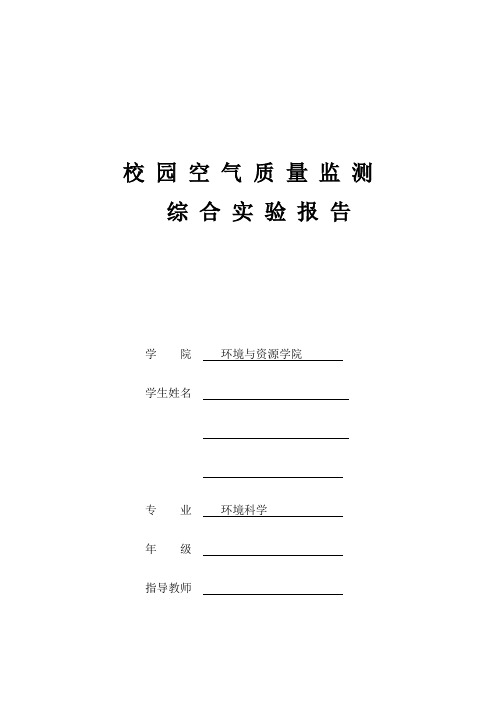
校园空气质量监测综合实验报告学院环境与资源学院学生姓名专业环境科学年级指导教师二Ο一Ο年十二月十八日校园空气质量监测综合实验报告前言山西省为产煤燃煤大省, 煤和其他化石燃料的的燃烧产生大量的SO2.NOx。
山西大学位于山西省省会太原市东南方向的城乡结合带, 紧临交通主干道坞城路, 附近有许西, 北张两个自主燃煤采暖的的城中村, 和一个垃圾焚烧厂。
煤和垃圾燃烧产生了大量的SO2.NOx, 同时汽车尾气液排放了大量的NOx。
其中SO2是主要空气污染物之一, 它能通过呼吸进入气管, 对局部组织产生刺激和腐蚀作用, 是诱发支气管炎等疾病的原因之一, 特别是当它与烟尘等气溶胶共存时可加重对呼吸道黏膜的损伤。
而NOx是引起支气管炎、肺损伤等疾病的有害物质。
TSP是大气环境中的主要污染物, 它可由燃煤、燃油、工业生产过程等人为活动排放出来, 也可以通过土壤、扬尘、沙尘经风力的作用输送到空气中而形成。
SO2.NOx和TSP都是环境监测必测项目, 通过对它们的测定可以及时全面地反映环境质量现状及发展趋势, 为保护人类健康和环境等服务。
一、实验目的和要求1.根据布点采样原则, 选择适宜方法进行布点, 确定采样频率及采样时间, 掌握测定空气中SO2.NOx 和TSP 的采样和监测方法。
2、根据三项污染物监测结果, 计算空气污染指数(API), 描述空气质量状况。
3、通过实验及计算直观的反映出山西大学校园的空气质量, 掌握环境监测的基本方法。
二、空气中SO2的测定(一)目的:1.掌握甲醛缓冲溶液吸收——盐酸副玫瑰苯胺分光光度法测定大气中SO2的方法;2.测量校园中SO2的浓度。
(二)原理:空气中的二氧化硫被四氯汞钾溶液吸收后, 生成稳定的二氯亚硫酸盐络合物, 此络合物再与甲醛及盐酸副玫瑰苯胺发生反应, 生成紫红色的络合物, 其最大吸收波长为577nm, 据其颜色深浅, 用分光光度法测定其吸光度, 与标准曲线对比, 对SO2进行含量回归, 从而测得空气中SO2的浓度。
实验室环境条件控制

实验室环境条件控制On January 11, 2021, study hard and make progress every day.实验室环境条件控制一、目的:为了确保分析检测的质量,提高检测结果的准确度;二、基本要求:实验室环境条件基本要求2.1.1 实验室的标准温度为20℃,一般检测间及试验间的温度应在20±5℃,天平室应为20±3℃,样品室温度≤32℃;2.1.2 实验室内的相对湿度一般应保持在40-70%;实验室的噪音、防震、防尘、防腐蚀、防磁与屏蔽等方面的环境条件应符合在室内开展的检测仪器设备对环境条件的要求,室内采光应利于检测工作的进行;实验室的环境条件出现异常,例如温度和湿度超过规定范围且明显影响检定或检测结果时,应及时报告室主任,并逐级报告质保部领导及公司有关领导;当环境条件经常出现异常情况检测工作时,应据实书面报告公司有关领导,采取适当措施给予解决;在已有的条件下,试验室要采取积极措施保管维护好计量仪器设备;实验室环境条件的日常控制与管理实验室应保持整齐洁净,每天工作结束后要进行必要的清理,定期擦拭仪器设备,仪器设备使用完后应将器具及其附件摆放整齐,盖上仪器罩或防尘布;一切用电的仪器设备使用完毕后均应切断电源;实验室内严禁吸烟、吃零食、喝水和存放食物等,非试验室人员未经同意不得进入室内;经同意进入的人员在人数上应严格控制,以免引起室内温度、湿度的波动变化;实验室由专人负责本室内温、湿度情况的记录;仓库由仓库挂管理员专人记录;标准溶液室由试剂配制人员记录;样品室由样品管理员记录;有空调室内不应随便开启门窗,指定专人负责操作空调设备;常规室、样品室由检测组长负责、仪器室有仪器操作员负责、标准溶液室由试剂配制人员负责、天平室由检测组长负责、仓库由仓库管理员负责;室内温、湿度情况记录由各计量、试验室保存,保存期三年;。
拱桥科学实验报告
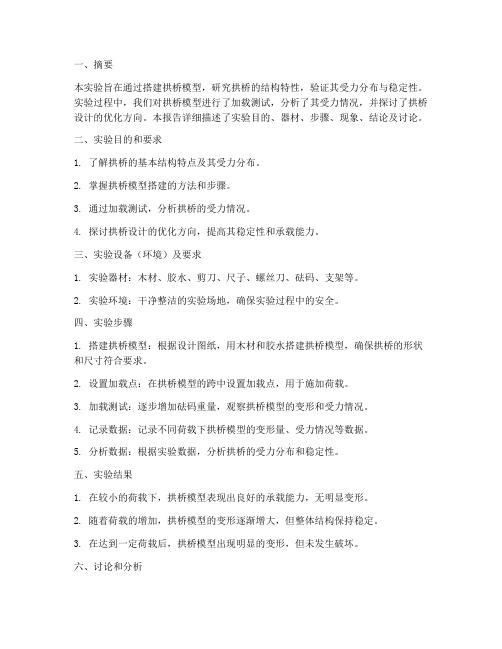
一、摘要本实验旨在通过搭建拱桥模型,研究拱桥的结构特性,验证其受力分布与稳定性。
实验过程中,我们对拱桥模型进行了加载测试,分析了其受力情况,并探讨了拱桥设计的优化方向。
本报告详细描述了实验目的、器材、步骤、现象、结论及讨论。
二、实验目的和要求1. 了解拱桥的基本结构特点及其受力分布。
2. 掌握拱桥模型搭建的方法和步骤。
3. 通过加载测试,分析拱桥的受力情况。
4. 探讨拱桥设计的优化方向,提高其稳定性和承载能力。
三、实验设备(环境)及要求1. 实验器材:木材、胶水、剪刀、尺子、螺丝刀、砝码、支架等。
2. 实验环境:干净整洁的实验场地,确保实验过程中的安全。
四、实验步骤1. 搭建拱桥模型:根据设计图纸,用木材和胶水搭建拱桥模型,确保拱桥的形状和尺寸符合要求。
2. 设置加载点:在拱桥模型的跨中设置加载点,用于施加荷载。
3. 加载测试:逐步增加砝码重量,观察拱桥模型的变形和受力情况。
4. 记录数据:记录不同荷载下拱桥模型的变形量、受力情况等数据。
5. 分析数据:根据实验数据,分析拱桥的受力分布和稳定性。
五、实验结果1. 在较小的荷载下,拱桥模型表现出良好的承载能力,无明显变形。
2. 随着荷载的增加,拱桥模型的变形逐渐增大,但整体结构保持稳定。
3. 在达到一定荷载后,拱桥模型出现明显的变形,但未发生破坏。
六、讨论和分析1. 实验结果表明,拱桥模型具有良好的承载能力和稳定性,符合设计要求。
2. 拱桥的受力分布主要集中于拱顶和拱脚,这与拱桥的结构特点有关。
3. 在设计拱桥时,应充分考虑拱桥的受力分布和稳定性,优化拱桥结构,提高其承载能力。
七、结论1. 本实验验证了拱桥结构在受力分布和稳定性方面的特点。
2. 通过实验,我们掌握了拱桥模型搭建的方法和步骤,为后续拱桥设计提供了参考。
3. 在实际工程中,应充分考虑拱桥的受力分布和稳定性,优化拱桥结构,确保工程安全。
八、改进建议1. 在实验过程中,可以尝试不同形状和尺寸的拱桥模型,进一步研究拱桥的受力特性。
实验 校园环境质量监测

1.使学生学会设计水质监测路线,确定水质监测项目,并对水质进行监测与评价。
2.使学生学会设计空气污染监测路线,确定空气监测项目,并对空气质量进行监测与评价。
3.使学生学会设计环境噪声监测路线,并对噪声进行监测与评价,绘制噪声污染图。
4.训练学生独立完成一项摹拟或者实际监测任务的能力、处理监测数据的能力以及综合分析和评价能力。
1.要求学生理论联系实际,实地调查,每一个学生都自己动手亲自制订方案,设计分析操作过程,处理实验数据,写出实验报告。
2 .实事求是地报出监测数据,实验结果准确可靠。
3.选择的项目要能够反映监测区水环境质量以及空气环境质量,选择的采样、分析监测方式要科学合理。
三.实验内容(一)校园水及污水监测1 .制订校园水及污水监测方案:对校园内污水及生活用水进行现场调查,对以下调查内容以表格或者其他能清晰表达的方式加以记录。
① 学生食堂用水包括哪几部份,各部份水中含的物质大致情况,每天用水量。
② 调查校医院污水去向,排水量。
③ 调查校园中各实验室的污水去向,排水量。
④调查生活污水(教工住宅区、学生宿舍)的排水量。
⑤调查校园内自来水用水量。
⑥校园内地表水情况等。
制订校园内水监测方案一览表,并确定监测项目。
2 .校园水、污水监测及结果分析:① 实施水及污水的监测具体安排:全班同学分成几组,每组负责几个项目的测定,拿到监测项目后,每组同学做好采样前准备工作(标准溶液及其他试剂配制;采样仪器、采样时的保存剂准备等)。
② 学生亲自动手进行水样采集、保存和预处理以及分析测试。
③ 水监测结果及分析:各项目分析监测及数据处理方法参看《水和污水监测分析方法》国家环保局编,也可参考《环境监测》(第三版)奚旦立主编或者本实验指导书的有关内容。
最后将结果汇总在表格中。
3 .对校园内水及污水水质进行简单评价:校园的水及污水水质与国家相应标准比较,并得出结论;分析校园水及污水水质现状;提出改善校园水及污水水质的建议及措施。
地球实验报告单(3篇)

第1篇实验名称:地球环境与生态系统研究实验时间:2023年X月X日至2023年X月X日实验地点:全球各地(包括但不限于中国、美国、欧洲、非洲、亚洲、南美洲等)实验目的:1. 了解地球环境的基本状况,包括大气、水、土壤、生物等方面的变化。
2. 探究人类活动对地球生态系统的影响。
3. 分析地球环境问题的成因及可能的解决方案。
4. 提高公众对环境保护的认识和意识。
实验方法:1. 收集全球各地的环境数据,包括气温、降雨量、土壤质量、水质、生物多样性等。
2. 分析人类活动对地球环境的影响,如工业排放、农业活动、城市化等。
3. 调查地球环境问题的成因,如气候变化、生物多样性丧失、资源枯竭等。
4. 研究地球环境问题的解决方案,如节能减排、生态保护、可持续发展等。
5. 通过问卷调查、访谈、实地考察等方式,了解公众对环境保护的认知和态度。
实验结果:一、地球环境状况1. 大气环境:- 全球平均气温持续上升,极端天气事件增多。
- 大气中二氧化碳浓度持续上升,导致温室效应加剧。
- 部分地区臭氧层破坏严重,影响人类健康。
2. 水环境:- 淡水资源短缺,部分地区出现水资源危机。
- 污染问题严重,河流、湖泊、海洋等水体受到污染。
- 海平面上升,沿海地区面临洪水威胁。
3. 土壤环境:- 土壤质量下降,土地退化现象严重。
- 化肥、农药等农业投入品对土壤造成污染。
- 土地沙漠化、盐碱化等问题加剧。
4. 生物多样性:- 生物多样性丧失严重,物种灭绝速度加快。
- 生态系统失衡,导致生物链断裂。
- 人类活动对野生动植物栖息地造成破坏。
二、人类活动对地球生态系统的影响1. 工业排放:- 火力发电、钢铁、水泥等行业排放大量二氧化碳、氮氧化物、硫氧化物等污染物。
- 工业废水、固体废弃物对水体、土壤造成污染。
2. 农业活动:- 大量使用化肥、农药,导致土壤、水体污染。
- 森林砍伐、草原退化,导致生物多样性丧失。
3. 城市化:- 城市扩张导致绿地减少,影响气候调节。
小学学生实验规则范文(二篇)

小学学生实验规则范文1. 实验目的:本次实验旨在提高小学学生的实践动手能力和观察分析能力,让他们通过实验亲身体验科学的乐趣,培养对科学的兴趣。
2. 实验安全:实验前,学生必须佩戴实验室指定的实验服和安全眼镜,以确保自身安全。
在实验过程中,任何时候都不允许开玩笑或粗心大意。
如果发生突发状况,请立即向老师报告。
3. 实验器材:学生在使用实验器材前,应先仔细观察器材的使用方法和注意事项,并确保器材完好无损。
在实验结束后,要及时清理和归还实验器材。
4. 实验操作:学生在进行实验操作前,要仔细阅读实验步骤,并确保自己理解清楚。
在操作过程中,应按照实验步骤逐一进行,不得随意改动。
操作过程中如有不明白或疑问,要及时向老师请教。
5. 观察记录:学生在进行实验过程中,要准确记录每个步骤的观察结果和数据变化。
观察记录应简明扼要,表达清晰,确保记录的准确性。
6. 结果分析:学生在实验完成后,要对实验结果进行分析和总结。
分析时应基于实验数据,运用科学知识进行推理和解释,并尽量做出科学合理的结论。
7. 实验报告:学生应根据实验要求,及时撰写实验报告。
报告内容要包括实验目的、实验过程、观察结果、数据分析和结论等。
报告要求书写规范、内容完整,语言简明扼要。
8. 实验守则:学生在实验室中要遵守实验守则,不得打闹、乱扔实验材料和妨碍他人实验。
实验过程中应保持实验台面整洁,注意个人卫生。
9. 实验合作:学生在进行实验时,应与同班同学积极合作,互相帮助,共同完成实验任务。
要遵守交流和合作的原则,尊重他人的意见和努力。
10. 实验态度:学生应保持积极、认真、负责的实验态度。
对于实验中遇到的问题和困难要勇于探究和解决,要善于思考和提问,不怕失败,不怕犯错。
通过以上实验规则,希望能够帮助小学学生更好地进行实验学习,培养他们的实践能力和科学思维,激发他们对科学的兴趣和探索欲望。
小学学生实验规则范文(二)以下是小学学生实验规则范本:实验规则:1. 遵守安全规定:- 在实验室内保持安静,不要喧哗或奔跑。
CC实验报告

.精选word范本!C2C实验报告一、实验目的和要求1. 掌握电子商务C2C模式的交易流程2. 掌握各角色在C2C流程中的功能3.掌握各角色之间的配合。
二、实验环境博星卓越电子商务教学试验系统三、实验内容本实验项目以博星电子商务模拟系统为平台,模拟B2B商务环境中各种商务角色的运作过程。
本实验中设计了商城会员和商城管理员两个角色。
小组成员中根据各自的角色,配合模拟会员之间在网城中进行“拍卖”或“竟标”商品的交易。
C2C的交易双方和管理员进入系统,完成个人档案的信息,并根据要求对自己信息进行相应的修改、删除和添加操作。
卖方和买方添加产品信息和描述。
商场平台管理员发布公告信息。
买卖双方进入C2C商场平台,交易开始。
买方查看产品信息,选购产品,选择交易模式,对卖方进行相关产品信息的提问。
卖方对提问回答。
交易双方谈成后完成交易。
买卖方向商场管理员进行意见反馈,管理员对反馈意见处理。
交易双方查看交易信息。
四、实验领会和总结C2C是电子商务中的一种重要的模式,是通过internet为消费者提供一个新型的购物环境,个人消费者通过网络在网上进行购物。
通过这种模式节省了买卖双方的时间和空间,大大提高了交易效率,节省了不必要的开支,使更多的人获益。
模拟实验中的网上洽谈其实很有趣,在实际交易中,更多要洽谈的东西还有很多,不仅是质量、款式、颜色,还会有更多,如运送方式和保险之类的。
以后有机会一定要再现实中去进行真正的洽谈。
通过实践操作,我熟练掌握了C2C交易的整个流程。
C2C给消费者足够自由的交易空间,这种模式在未来将会有很大的发展空间。
正点原子潘多拉开发板实验指导书
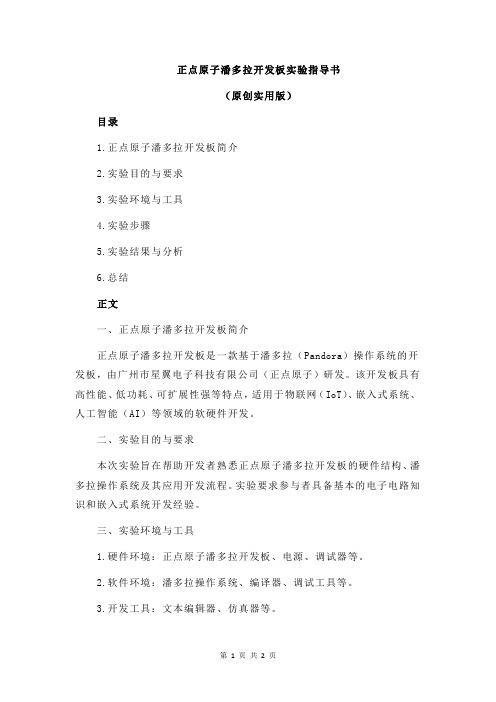
正点原子潘多拉开发板实验指导书
(原创实用版)
目录
1.正点原子潘多拉开发板简介
2.实验目的与要求
3.实验环境与工具
4.实验步骤
5.实验结果与分析
6.总结
正文
一、正点原子潘多拉开发板简介
正点原子潘多拉开发板是一款基于潘多拉(Pandora)操作系统的开发板,由广州市星翼电子科技有限公司(正点原子)研发。
该开发板具有高性能、低功耗、可扩展性强等特点,适用于物联网(IoT)、嵌入式系统、人工智能(AI)等领域的软硬件开发。
二、实验目的与要求
本次实验旨在帮助开发者熟悉正点原子潘多拉开发板的硬件结构、潘多拉操作系统及其应用开发流程。
实验要求参与者具备基本的电子电路知识和嵌入式系统开发经验。
三、实验环境与工具
1.硬件环境:正点原子潘多拉开发板、电源、调试器等。
2.软件环境:潘多拉操作系统、编译器、调试工具等。
3.开发工具:文本编辑器、仿真器等。
四、实验步骤
1.熟悉开发板硬件结构,包括处理器、内存、外设接口等。
2.安装潘多拉操作系统和相关软件工具。
3.使用文本编辑器编写程序,并通过编译器编译。
4.将编译好的程序下载到开发板上进行调试。
5.观察运行结果,并对程序进行优化。
五、实验结果与分析
通过以上步骤,开发者可以熟悉正点原子潘多拉开发板的使用流程,掌握潘多拉操作系统的应用方法,并实现简单的嵌入式系统开发。
实验结果可以验证开发者的编程能力和对系统的理解程度。
六、总结
正点原子潘多拉开发板实验指导书旨在帮助开发者快速上手,掌握嵌入式系统开发的基本技能。
实验室环境卫生管理制度范文(三篇)
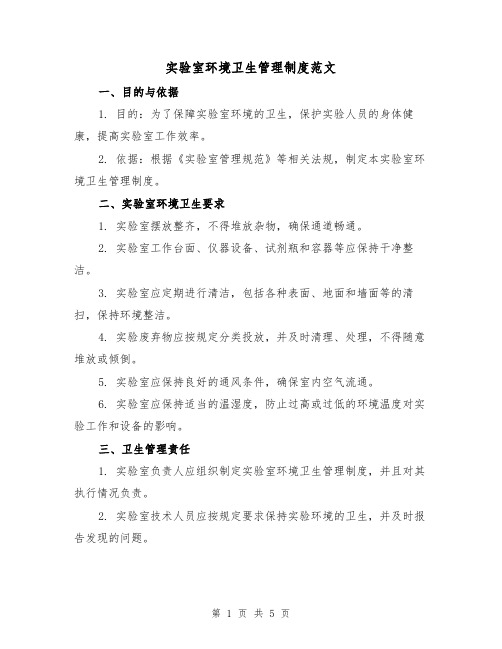
实验室环境卫生管理制度范文一、目的与依据1. 目的:为了保障实验室环境的卫生,保护实验人员的身体健康,提高实验室工作效率。
2. 依据:根据《实验室管理规范》等相关法规,制定本实验室环境卫生管理制度。
二、实验室环境卫生要求1. 实验室摆放整齐,不得堆放杂物,确保通道畅通。
2. 实验室工作台面、仪器设备、试剂瓶和容器等应保持干净整洁。
3. 实验室应定期进行清洁,包括各种表面、地面和墙面等的清扫,保持环境整洁。
4. 实验废弃物应按规定分类投放,并及时清理、处理,不得随意堆放或倾倒。
5. 实验室应保持良好的通风条件,确保室内空气流通。
6. 实验室应保持适当的温湿度,防止过高或过低的环境温度对实验工作和设备的影响。
三、卫生管理责任1. 实验室负责人应组织制定实验室环境卫生管理制度,并且对其执行情况负责。
2. 实验室技术人员应按规定要求保持实验环境的卫生,并及时报告发现的问题。
3. 实验室管理人员应定期检查实验环境卫生情况,并及时采取纠正措施。
四、实验室环境卫生管理措施1. 每周开展一次实验室卫生检查,记录具体问题并及时整改。
2. 实验室工作区域常备清洁设备和工具,保持清洁维护的方便性。
3. 针对可能产生废弃物的实验项目,提前做好废弃物的处置计划,确保及时清理和处理。
4. 定时检查实验室的水源、电源和排风系统等设施,保障其正常运行和安全使用。
5. 定期对实验室进行消毒,包括实验台面、器皿、微生物实验室等区域的消毒处理。
6. 当实验室发生突发情况或事故时,应立即上报,并及时采取紧急措施进行处理和清理。
五、培训和教育1. 新入职的实验室技术人员应接受实验室环境卫生管理的培训,并理解相关规定和要求。
2. 实验室负责人应定期开展实验室环境卫生管理的培训,以提高实验人员的意识和能力。
六、违规处理1. 发现个人或单位存在违反实验室环境卫生管理制度的行为,将依法依规进行处理。
2. 违规行为可能会导致个人或单位受到纪律处分,并承担相应的法律责任。
大气的环境实验报告(3篇)

第1篇一、实验目的和要求1. 了解大气环境的组成及其特性。
2. 掌握大气环境监测的基本方法。
3. 分析大气污染物的来源及危害。
4. 评估大气环境质量。
二、实验设备(环境)及要求1. 实验设备:大气采样器、大气污染物检测仪、气象仪器、电脑等。
2. 实验环境:室外大气环境,要求环境安静、无污染。
三、实验步骤1. 实验前准备:检查实验设备是否完好,确认实验环境符合要求。
2. 设置采样点:选择具有代表性的采样点,如居民区、工业区、交通干线等。
3. 大气采样:使用大气采样器采集大气样品,记录采样时间、地点等信息。
4. 大气污染物检测:使用大气污染物检测仪对采样样品进行检测,包括二氧化硫、氮氧化物、颗粒物等污染物。
5. 气象数据采集:使用气象仪器采集采样点的温度、湿度、风向、风速等气象数据。
6. 数据处理与分析:将采集到的数据输入电脑,进行统计分析,评估大气环境质量。
四、实验结果1. 大气污染物检测结果:二氧化硫浓度0.5mg/m³,氮氧化物浓度0.3mg/m³,颗粒物浓度50mg/m³。
2. 气象数据:温度25℃,湿度60%,风向东南,风速2m/s。
五、讨论和分析1. 大气污染物来源:根据检测结果,本次实验采样点大气污染物主要来源于交通、工业等污染源。
2. 大气污染物危害:大气污染物对人类健康、生态环境等产生严重影响,如引发呼吸系统疾病、植物生长受阻等。
3. 大气环境质量评估:根据检测结果,本次实验采样点大气环境质量较差,需加强污染源治理。
六、实验结论1. 本次实验成功采集到大气样品,并检测出二氧化硫、氮氧化物、颗粒物等污染物。
2. 采样点大气环境质量较差,需采取有效措施降低污染物排放,改善大气环境质量。
3. 大气环境监测对评估大气污染状况、保护生态环境具有重要意义。
注:本实验报告仅供参考,实际实验结果可能因实验条件、采样点等因素而有所不同。
第2篇一、实验目的和要求1. 了解大气环境的基本概念和组成。
南邮IP网络技术实验报告
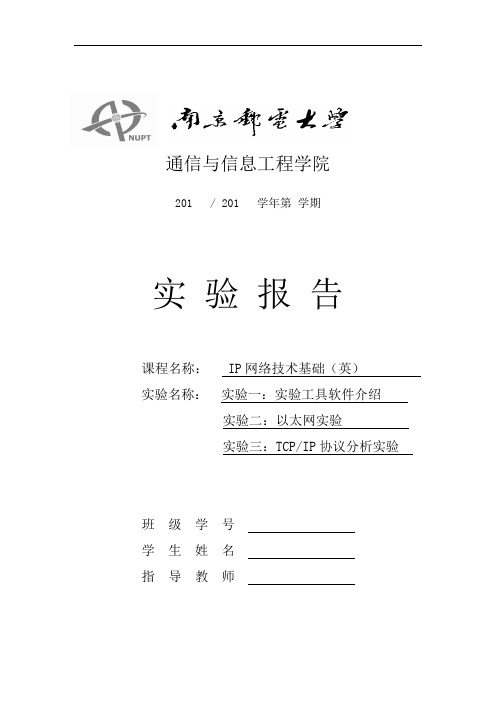
通信与信息工程学院201 / 201 学年第学期实验报告课程名称: IP网络技术基础(英)实验名称:实验一:实验工具软件介绍实验二:以太网实验实验三:TCP/IP协议分析实验班级学号学生姓名指导教师实验一:实验工具软件介绍一、实验目的和要求:1.通过该实验能掌握常用网络工具的使用,为后面的实验做准备。
2.能够利用这些工具了解网络的运行状态。
二、实验环境:1采用方案一进行实验,学生每人微机一台和一个虚拟机编号,安装光盘中的/book/tools目录下的虚拟机和软件工具,再次利用VMware运行光盘系统并按照虚拟机编号选择IP地址,另外教师可利用随书光盘系统架设被观测网络(三物理机或三虚拟机,使用备用地址)。
2 实验涉及软件的列表如下:被动式工具:NetXray, Netmonitor, WinPcap/Ethereal,tcpdump主动式工具:ping,route, traceroute,nslookup,iperf,SNMP_utils,trapwatcher。
综合工具:solarwinds,IPSwitch。
其中tcpdump、ping、route、traceroute、nslookup、SNMP_utils 几个软件在随书光盘系统中已经安装好了,无需额外安装。
请注意NetXray、Netmonitor、solarwinds和IPSwitch有问题。
三、实验原理:通过被动工具,获得并分析数据包;通过主动工具发现网络问题(可以手工制造);通过强大的综合工具对网络进行分析。
四、实验步骤:(包含结果分析)软件安装安装各种工具软件。
安装各种供测试的应用软件。
实验环节被动工具windows:Ethereal;主动工具windows:ping,ipconfig, tracert,iperf,trapwatcher.五、实验心得IP网络技术主要讲述网络基础知识, 虽然不是广电的主修课程,但对于我们大学生解决实际的网络问题有着指导作用。
实验室环境控制要求
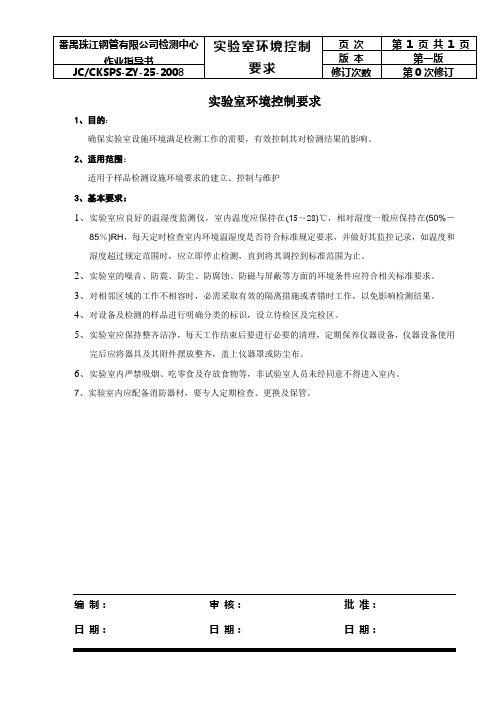
实验室环境控制要求
1、目的:
确保实验室设施环境满足检测工作的需要,有效控制其对检测结果的影响。
2、适用范围:
适用于样品检测设施环境要求的建立、控制与维护
3、基本要求:
1、实验室应良好的温湿度监测仪,室内温度应保持在(15~28)℃,相对湿度一般应保持在(50%-
85%)RH,每天定时检查室内环境温湿度是否符合标准规定要求,并做好其监控记录,如温度和湿度超过规定范围时,应立即停止检测,直到将其调控到标准范围为止。
2、实验室的噪音、防震、防尘、防腐蚀、防磁与屏蔽等方面的环境条件应符合相关标准要求。
3、对相邻区域的工作不相容时,必需采取有效的隔离措施或者错时工作,以免影响检测结果。
4、对设备及检测的样品进行明确分类的标识,设立待检区及完检区。
5、实验室应保持整齐洁净,每天工作结束后要进行必要的清理,定期保养仪器设备,仪器设备使用
完后应将器具及其附件摆放整齐,盖上仪器罩或防尘布。
6、实验室内严禁吸烟、吃零食及存放食物等,非试验室人员未经同意不得进入室内。
7、实验室内应配备消防器材,要专人定期检查、更换及保管。
编制:审核:批准:
日期:日期:日期:。
森林公园生态环境野外调查

森林公园生态环境野外调查环境科学 2007级组员:一、实验目的通过本实验的学习,是学生熟悉生态环境野外调查的基本内容和方法,包括熟悉实验前对森林公园生态环境特征资料收集、基本图件收集和野外基本工具的准备,在此基础上对调查路线和调查内容的设计、野外调查内容的实地记录和监测以及调查结果的整理,为学生今后从事生态环境评价、生态环境规划和生态环境建设等工作奠定基础。
二、实验基本要求在掌握陆地生态系统特征等理论基础上,重点掌握森林公园实际的生态环境状况,并通过查考有关文献资料进行归纳总结,提出需要调查的核心内容;根据森林公园当地实际情况选择调查地点、野外实测项目,收集调查需要的工具和仪器;掌握野外调查工具的使用方法和数据记录表格设计;对调查内容进行整理,按确定的思路编制生态环境调查报告。
三、主要仪器及资料1、主要仪器:GPS,红外测距仪,照度计,湿度计,坡度仪,地质罗盘,照相机,卷尺,小刀,植物采集记录本,标签,植物标本夹等2、基础图件:地形图、植被图、土地利用图、航空像片等室内判读四、实验内容与步骤1、掌握生态学理论内容:陆地生态系统,生态系统中的物质循环和能量流动等基础知识。
2、通过野外调查森林公园当地主要生态系统类型、生态环境特征等有关资料。
3、收集调查地区-森林公园生态环境的有关资料,包括地图、航片、已有的环评报告或生态环境调查报告、文献中的有关研究论文等,对调查地区有初步的感性认识和了解,从生态系统类型、特征、结构功能、生物气候特征、受人类活动干扰程度等方面对已有知识点进行归类。
4、查找出反应调查地区生态环境特征的核心内容和目前需要了解补充的内容。
5、根据调查内容设计调查路线和调查方案,并进行分工负责,设计路线。
6、确定调查用到的主要仪器和设备,列好清单进行整理。
7、野外调查实施:进行野外测试和记录。
8、野外调查结果整理。
五、实验注意事项1、野外调查的分组分工合理,每4个人为一小组。
2、野外调查的安全问题,每小组选出1名小组长负责安全。
- 1、下载文档前请自行甄别文档内容的完整性,平台不提供额外的编辑、内容补充、找答案等附加服务。
- 2、"仅部分预览"的文档,不可在线预览部分如存在完整性等问题,可反馈申请退款(可完整预览的文档不适用该条件!)。
- 3、如文档侵犯您的权益,请联系客服反馈,我们会尽快为您处理(人工客服工作时间:9:00-18:30)。
一、实验目的,实验要求及实验环境
目的:掌握词法分析的基本方法。
具有设计各种常见语言成分的目标结构的能力
要求:编写一个词法分析程序,对给出的程序段进行词法分析,要求输出以文件形式存放的TOKEN串和符号表
环境:Microsoft Visual C++6.0
二、实验用到的词类编码表
main 0
( 2
) 3
a 0
: 4
int 6
; 5
b 0
: 4
int 6
; 5
{ 6
if 4
a 0
> 8
0 1
and 5
c 0
> 8
0 1
then 7
a 0
= 9
0 1
else 3
a 0
= 9
1 1
; 5
while 8
a 0
< 10
5 1
do 2
a 0
= 9
a 0
+ 11
1 1
} 7
三、设计符号表的逻辑结构及存贮结构
实验中用到的关键字表,限界符、运算符表均存储在文件中,因此没用到结构。
每次查询时只需打开文件查阅。
关键字表(keyword.txt):
do
else
if
and
int
then
while
运算符、限界符表(limit.txt):
(
)
:
;
{
}
>
=
<
+
四、词法分析程序中主要模块的算法
识别标识符的算法:
//以字母和下划线开头
if (((ch >= 'A') && (ch <= 'Z')) || ((ch >= 'a') && (ch <= 'z')) || (ch == '_')){
while(((ch >= 'A') && (ch <= 'Z')) || ((ch >= 'a') && (ch <= 'z')) || (ch == '_') || ((ch >= '0') && (ch <= '9'))){
array[i++]=ch;
ch = fgetc(fp);
}
word=(char*)malloc((i + 1) * sizeof(char));
memcpy(word, array, i);
word[i] = '\0';
intdeal(word);
if (ch != EOF){
fseek(fp, -1, SEEK_CUR);
}
}
识别特殊符号/的算法:
分三种情况:/=、/、 /*
//消除注释
else if (ch == '/'){
ch = fgetc(fp);
if (ch == '='){ //判断是否为‘/=’号
outputfp = fopen("token.txt", "a");
fprintf(outputfp, "/=\t4\t\t\t13\n");
fclose(outputfp);
}
else if (ch != '*'){ //若为除号,写入输出文件
outputfp = fopen("token.txt", "a");
fprintf(outputfp, "/\t4\t\t\t13\n");
fclose(outputfp);
fseek(fp, -1, SEEK_CUR);
}
else if (ch == '*'){ //若为注释的开始,则忽略注释内容
count=0;
ch = fgetc(fp);
while(count!=2){ //当扫描到‘*’且紧接着下一个字符为‘/’才是注释的结束
count=0;
while(ch != '*')
ch = fgetc(fp);
count++;
ch = fgetc(fp);
if(ch=='/')
count++;
else
ch = fgetc(fp);
}
}
}
识别界限符
//首字符为其它字符,即运算限界符或非法字符
else {
errorno = 0;
array[0] = ch;
ch = fgetc(fp); //再读入下一个字符,判断是否为双字符运算、限界符
if (ch != EOF){
array[1]=ch;
word = (char*)malloc(3 * sizeof(char));
memcpy(word, array, 2);
word[2] = '\0';
//先检索是否为双字符运算、限界符
result = search(word, 2, 1);
if (result == 0){ //若不是
word = (char*)malloc(2 * sizeof(char));
memcpy(word, array, 1);
word[1] = '\0';
result = search(word, 2, 1); //检索是否为单字符运算、限界符
if (result == 0){ //若还不是,则为非法字符
errordeal(array[0], line);
errorno++;
fseek(fp, -1, SEEK_CUR);
}
else { //若为单字符运算、限界符,写入输出文件并将扫描文件指针回退一个字符
outputfp = fopen("token.txt", "a");
fprintf(outputfp, "%d\n", result);
fclose(outputfp);
fseek(fp, -1, SEEK_CUR);
}
}
else { //若为双字符运算、限界符,写入输出文件
outputfp = fopen("token.txt", "a");
fprintf(outputfp, "%d\n", result);
fclose(outputfp);
}
}
else { //若读入的下一个字符为文件结束符
word = (char*)malloc(2 * sizeof(char));
memcpy(word, array, 1);
word[1] = '\0';
result = search(word, 2, 1); //只考虑是否为单字符运算、
限界符
if (result == 0) //若不是,转出错处理
errordeal(array[0], line);
else { //若是,写输出文件
outputfp = fopen("token.txt", "a");
fprintf(outputfp, "%d\n", result);
fclose(outputfp);
}
}
}
五、测试程序
放在test.txt中
main()
a:int;
b:int;
{
if a>0 and c>0 then a=0 else a=1;
while a<5 do
a=a+1
}
六、测试结果
token.txt(存放tocken字)
0 3606440
2
3
0 3606720
4
6
5
0 3607056
4
6
5
6
4
0 3607560
8
1 3607728
5
0 3607840
8
1 3608008
7
0 3622304
9
1 3655632
3
0 3655744
9
1 3622472
5
8
0 3622696
10
1 3622864
2
0 3622976
9
0 3668368
11
1 3668536
7
identifier.txt(存放符号表)
main0
a 0
b 0
c 0
关于结果的几点说明:token.txt第一列为每个单词的编码,后一列为其属性值,关键字、运算符、限界符的属性值均为空,未打印出来。
常数和标识符的属性值为其在符号表的入口地址,这里取的是其在内存中的地址。
identifier.txt第一列是识别出来的标识符,后一列是其相应的编码,因为标识符的编码为一类,这里编为0,常数的编码为1,其他均为一字一码,在编码表里可以看出。
